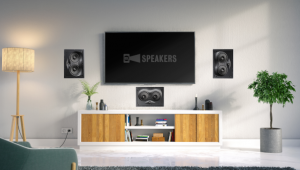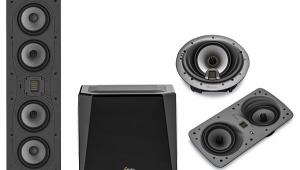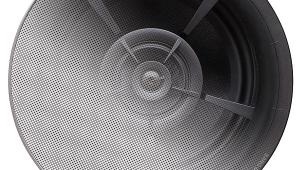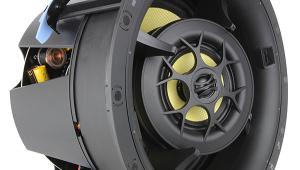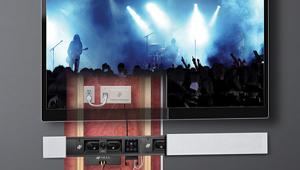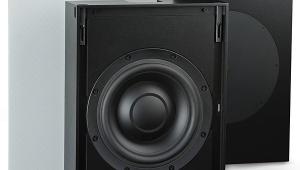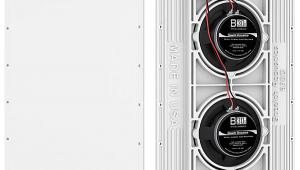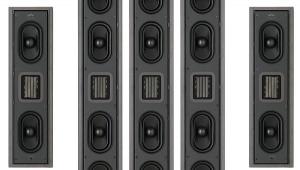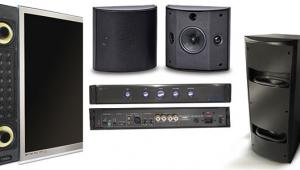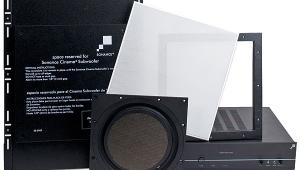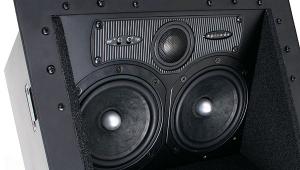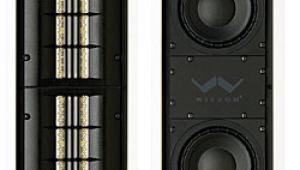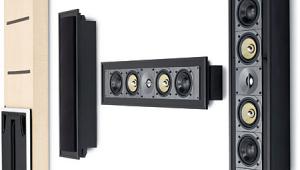Sunfire HRS-IW8 In-Wall Subwoofer and Amp
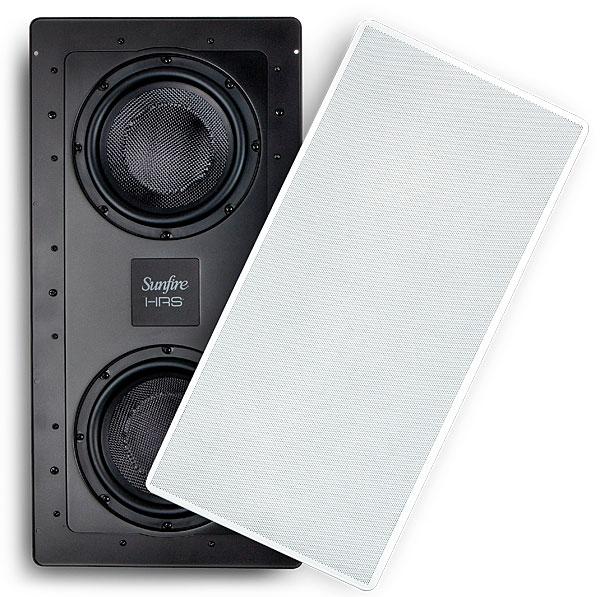
AT A GLANCE
Plus
Stillbass anti-shake technology keeps vibration in the box and out of the wall
520-watt amplifier with DSP equalization
Outstanding build quality
Minus
Flangeless grille looks less than elegant
Output drops off fast below 30 Hz
THE VERDICT
A solid, albeit pricey, choice for an in-wall sub.
Sunfire is no stranger to the small-box, high-output subwoofer concept, dating all the way back to 1996 with company founder Bob Carver’s original True Subwoofer—an 11.5-inch cube with one active driver and one passive radiator powered by a (claimed) 2,700-watt internal amplifier. A couple of years ago, the company rejiggered the configuration, moved the amp to a separate chassis, and put two 10-inch woofers in a 4-inch-deep box that would fit in a standard wall. To prevent the SubRosa SRS-210W from shaking the crap out of the wall it was hiding in, Sunfire borrowed the Third Law of Motion from Isaac Newton (don’t worry, he won’t miss it) and installed an “IBEAM device” inside the subwoofer cabinet that creates an equal but opposite force to cancel the mechanical vibrations that would normally be transferred to the cabinet when the drivers move. This is the essence of Sunfire’s StillBass technology.

The HRS-IW8 is a junior version of the SubRosa described above. The HRS-IW8’s 24.63 x 12.13 x 3.75-inch cabinet also easily fits (vertically) in a standard stud wall, but the sub’s cabinet contains a pair of smaller, 8-inch, active woofers powered by an external 520-watt amplifier. (Although the HRS-IW8 system normally ships as a one-amp/one-sub package, the HRS-IW8 amplifier is somewhat unusual in that it can drive up to two HRS-IW8 cabinets.) The system comes with a small, credit-card-size, IR remote control that provides access to the five preprogrammed EQ presets, sub volume level, night mode on/off, and other menu functions. The amplifier’s chassis is thin (1.75 inches high) with a beautifully simple and elegant faceplate that sports a small backlit display, a round control knob, and a power button. Its built-in system integration capabilities are very basic and limited to an external IR receiver input and one 12-volt trigger input. Sunfire claims a frequency response of 33 to 150 Hz for a single HRS-IW8 and amp.
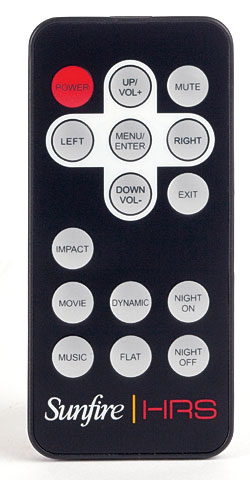 Face-Off
Face-Off
The HRS-IW8 subwoofer cabinet is straightforward to install and uses six dog-ear-style clamps (three on each side) to secure the cabinet to the wallboard. A shallow channel wire runs from top to bottom on the backside of the cabinet. Sunfire says that, in addition to conveniently providing a bit of room for the speaker wire, the channel helps support the weight of the wire and keeps it from pulling on the binding posts. The build quality of both the woofer cabinet and the amplifier is top-notch, and the 12 small magnets on the inside of the metal grille maintain a near-death-grip hold
on the face of the cabinet. The flangeless grille, however, sits on the surface of the wall and juts out nearly three-eights of an inch into the room. The lack of a flange makes the transition from wall to grille more noticeable, and that, combined with the grille’s relatively large perforations, makes it look a bit less sophisticated than it actually is. Setting up the amp’s minimal number of programmable para-
meters is quite fast and easy.
Putting the Hammer Down
There’s no doubt that the Sunfire HRS-IW8 is an attention-getter. It had plenty of kick that easily filled my 12 x 24-foot theater room, and the Music mode EQ setting added a nice emphasis in the lower bass region that pleasantly warmed up Dire Straits’s old classic “Telegraph Road.” It was also quite impressive with heavy-hitting movie scenes, such as the encounter Thor has initially with Iron Man and then Captain America in The Avengers, especially when Thor puts the hammer down on Captain America’s shield. As with just about any in-wall subwoofer, however, it’s not a match for an equivalently priced in-room sub, such as the $1,800 Legacy Audio Metro sub I recently fell in love with.
While it’s a highly respectable architectural subwoofer, there were several drawbacks I found with the Sunfire HRS-IW8, foremost of which is the lack of substantial output below 30 Hz. (Sunfire rates the HRS-IW8 down to 33 Hz, but with the sub installed in the wall near a corner in the front of my theater room, the HRS-IW8 actually got down to 30 Hz before rapidly tailing off.) Another issue is the amplifier’s lack of extensive EQ customization or system integration features. Since so many AVRs and pre/pros now include high-performance acoustic correction capabilities, though, this is probably a minor issue. The last concern, as I’ve previously mentioned, is the clunky-looking grille. Even with those caveats, the Sunfire HRS-IW8 certainly remains a good choice for most theater rooms needing a hidden subwoofer, albeit a slightly pricey one.
- Log in or register to post comments
